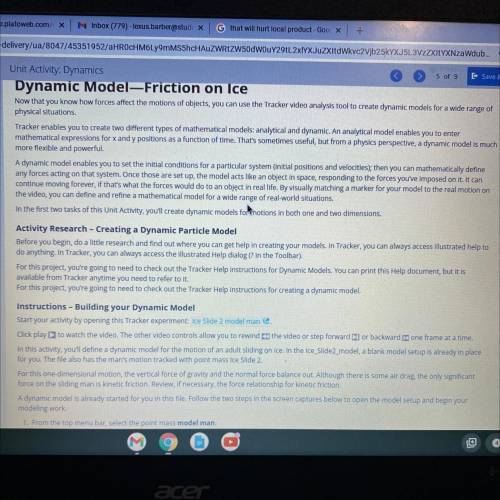
Physics, 27.10.2021 09:00, natalie2sheffield
Now that you know how forces affect the motions of objects, you can use the Tracker video analysis tool to create dynamic models
for a wide range of physical situations.
Tracker enables you to create two different types of mathematical models: analytical and dynamic. An analytical model enables you
to enter mathematical expressions for x and y positions as a function of time. That's sometimes useful, but from a physics
perspective, a dynamic model is much more flexible and powerful.
A dynamic model enables you to set the initial conditions for a particular system (Initial positions and velocities); then you can
mathematically define any forces acting on that system. Once those are set up, the model acts like an object in space, responding to
the forces you've imposed on it. It can continue moving forever, if that's what the forces would do to an object in real life. By visually
matching a marker for your model to the real motion on the video, you can define and refine a mathematical model for a wide range
of real-world situations.
In the first two tasks of this Unit Activity, you'll create dynamic models for motions in both one and two dimensions.
Activity Research - Creating a Dynamic Particle Model
Before you begin, do a little research and find out where you can get help in creating your models. In Tracker, you can always access
illustrated help to do anything. In Tracker, you can always access the illustrated Help dialog (? In the Toolbar).
For this project, you're going to need to check out the Tracker Help Instructions for Dynamic Models. You can print this Help
document, but it is available from Tracker anytime you need to refer to it.
For this project, you're going to need to check out the Tracker Help Instructions for creating a dynamic model.
Instructions - Building your Dynamic Model


Answers: 2
Other questions on the subject: Physics

Physics, 21.06.2019 13:30, lucky1940
Me ! a 2 µc charge q1 and a 2 µc charge q2 are 0.3 m from the x-axis. a 4 µc charge q3 is 0.4 m from the y-axis. the distances d13 and d23 are 0.5 m. find the magnitude and direction of the resulting vector r. round your answer to the nearest tenth.
Answers: 2

Physics, 21.06.2019 20:20, jacesmokesloud7254
Copper has free electrons per cubic meter. a 71.0-cm length of 12-gauge copper wire that is 2.05 mm in diameter carries 4.85 a of current. (a) how much time does it take for an electron to travel the length of the wire? (b) repeat part (a) for 6-gauge copper wire (diameter 4.12 mm) of the same length that carries the same current. (c) generally speaking, how does changing the diameter of a wire that carries a given amount of current affect the drift velocity of the electrons in the wire?
Answers: 2

Physics, 21.06.2019 22:00, Iron2841
Animals respond in various ways to stimuli detected through their senses. some of these responses are stimulated by the presence of danger. which of these animal responses is the best example of a response to an immediate threat? a) a rooster crows every morning at the first sign of light. b) as something approaches an octopus, it shoots a cloud of ink. c) from late fall until spring, bears hibernate to preserve energy. reactivate d) a dog is getting hot in the sunlight, so he moves to a shaded area.
Answers: 2

Physics, 22.06.2019 02:00, LadyHolmes67
The motor m applies a time-varying force of f (200 t) n, where t is in seconds. box b with mass 200 kg starts from rest, and the coefficients of kinetic and static friction are 0.2 and us 0.3 the acceleration due to gravity is g 9.8 m/s2 b 300 a) find the time ' when the box starts to move. b) calculate the speed of the crate at 3 s c) calculate the power delivered by the motor at t 3 s
Answers: 3
Do you know the correct answer?
Now that you know how forces affect the motions of objects, you can use the Tracker video analysis t...
Questions in other subjects:

Geography, 24.06.2019 05:00








Biology, 24.06.2019 05:00






